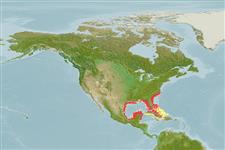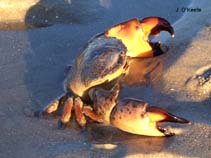Menippe mercenaria (Say, 1818)
Stone crab| Native range | All suitable habitat | Point map | Year 2050 |

|
| This map was computer-generated and has not yet been reviewed. |
| Menippe mercenaria AquaMaps Data sources: GBIF OBIS |
Classification / Names Common names | Synonyms | CoL | ITIS | WoRMS
Malacostraca | Decapoda | Menippidae
Environment: milieu / climate zone / depth range / distribution range Ecology
Benthic; depth range 0 - 60 m (Ref. 114309). Tropical, preferred 25°C (Ref. 107945); 35°N - 18°N, 98°W - 71°W
Distribution Countries | FAO areas | Ecosystems | Occurrences | Introductions
Western Central Atlantic: from Mexico to Turks and Caicos, then Cape Lookout North Carolina south to Jamaica.
Length at first maturity / Size / Weight / Age
Maturity: Lm 6.6 range ? - ? cm
Short description Morphology
Carapace transversely oval, about 2.3 times as long as wide, convex, nearly smooth to unaided eye, minutely granulate and punctate; anterolateral margins (excluding outer orbital teeth) divided into 4 lobes, front (excluding inner orbital angles) with a median notch and a broad tri-lobate lobe on each side. Pincers large and heavy, unequal, nearly smooth; inside of hands with patch of fine, oblique, parallel striae; walking legs stout and hairy distally. Color: juveniles dark purplish blue, very young with legs banded cream and red and white spot on carpus of pincer. Older individual become dark brownish red to black or less mottled and spotted with dusky grey; fingers dark; walking legs with reddish and yellow bands.
Occurs at depths down to 60 m (Ref. 114309). Burrows in mudflats just below low-tide mark, among rocks on jetties, on offshore reef areas, under rocks or coral heads and among dead shells or grass clumps (Ref. 367), burrows in seagrass beds, oyster reefs and crevices in rocks (Ref. 114309). Occasionally burrow in colonies. Tolerant to salinities considerably lower or higher than 35. Somewhat active both day and night, greatest activity observed during the evening before dark. Preys on oysters and other mollusks (Ref. 367).
Life cycle and mating behavior Maturity | Reproduction | Spawning | Eggs | Fecundity | Larvae
Ovigerous females are known from May to September.
Main reference
References | Coordinator | Collaborators
Tavares, M. 2003. (Ref. 367)
IUCN Red List Status (Ref. 130435)
CITES status (Ref. 108899)
Not Evaluated
CMS (Ref. 116361)
Not Evaluated
Threat to humans
Human uses
Fisheries: commercial
FAO - Fisheries: landings | FishSource | Sea Around Us
Tools
More information
Internet sources
BHL | BOLD Systems | CISTI | DiscoverLife | FAO(Fisheries: ; publication : search) | Fishipedia | GenBank (genome, nucleotide) | GloBI | Gomexsi | Google Books | Google Scholar | Google | PubMed | Tree of Life | Wikipedia (Go, Search) | Zoological Record
Estimates based on models
Preferred temperature
(Ref. 115969): 23.5 - 28, mean 25.6 (based on 210 cells).
Nutrients: Calcium = 109 [35, 184] mg/100g; Iron = 1.59 [1.21, 1.97] mg/100g; Protein = 20.2 [19.2, 21.3] %; Omega3 = 0.285 [0.185, 0.386] g/100g; Selenium = 48.3 [-31.7, 128.3] μg/100g; VitaminA = 0 μg/100g; Zinc = 1.79 [1.17, 2.40] mg/100g (wet weight).



